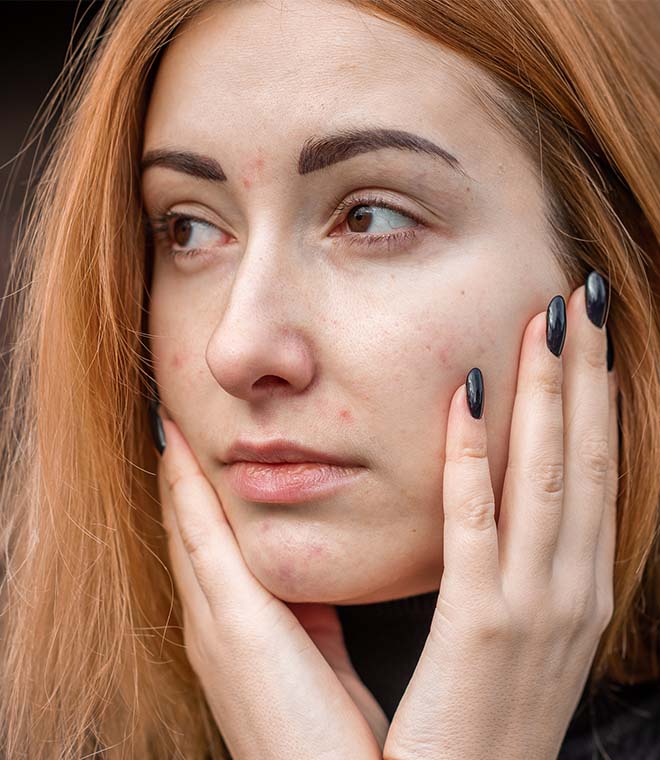Health
Do acne scars go away?
By Anna H. Chacon, MD, Fellow of the American Academy of Dermatology Apr 08, 2024 • 14 min
Acne scars can be devastating for many people who finally achieve clear skin after fighting acne, only to see unsightly facial marks left behind. Acne marks can cause low self-esteem and stress, especially when they’re on the face. The good news is that if acne scars are interfering with your quality of life, there are a number of effective acne scar treatments that can help fade and minimize marks — even if your scars are widespread or pitted.
Why does acne leave scars?
Acne lesions can penetrate the skin deeply and damage the tissues in the deeper layers. When the acne heals, your body tries to repair the tissue damage by producing collagen, a substance that gives your skin support. If your body produces too much collagen — or not enough — a scar will typically form.
More severe forms of acne that cause pus-filled cysts, or nodules, deep under the skin typically result in the most severe scarring, although moderate acne involving inflamed pimples (papules) or red pimples with white centers (pustules), as well as mild acne with whiteheads and blackheads, may also cause scarring. Acne scars may be worse in people who squeeze or pick at acne lesions.
Types of acne scars
Two main types of acne scars may appear as acne heals: depressed/sunken or raised scars. If your body doesn’t produce enough collagen, depressions may be evident as the skin heals. If your body produces too much collagen, a raised scar may develop.
Acne atrophic scars
Depressed acne scars are known as atrophic scars, or pitted acne scars. These occur when the body doesn’t produce enough collagen. Atrophic acne scars most often occur on the face and are categorized into three types:
- Rolling acne scars. These scars are shallow and have soft, sloping edges, creating a wavy appearance on the skin.
- Boxcar acne scars. These scars are typically broad, squarish depressions with edges that are sharply defined. They’re caused by widespread acne and usually form on thicker skin, like the skin on the lower cheeks and jaw.
- Ice pick acne scars. These small, narrow scars are indentations that point downward into the surface of the skin. They’re most common on the cheeks, and they may be difficult to remove without aggressive treatment.
Acne hypertrophic scars
Also known as hypertrophic scars, raised scars occur when the body produces too much collagen. Acne hypertrophic scars most commonly occur on the chest and back, and they’re more common in people with darker skin tones.
Acne keloid scars are a type of hypertrophic scar that also occur most often in people with darker skin. Acne keloid scars form when the skin has very high amounts of collagen and a decrease in elastin, resulting in raised, thick scars. Acne keloid scars appear as firm, rubbery nodules that extend beyond the area of the healed acne lesion. Keloid scars may cause pain, burning or itching.
Hyperpigmentation from acne
In addition to scars, acne may leave behind hyperpigmentation, or dark spots, after breakouts heal. Hyperpigmentation can be as tough to treat as scars. But some of the acne scar treatments available can also be used to lighten these dark spots. Other types of acne spots, like small red or brown spots, usually fade over a relatively short period of time.
Do acne scars go away on their own?
Reddish or brownish acne marks left behind by acne lesions usually fade eventually, but it can take a year or longer. Mild or moderate scarring may also fade over time, but in general, unless acne scars are treated — especially severe scarring — they’re permanent.
How to get rid of acne scars
There’s no sure way to get rid of all acne scars. Different types of acne scars require different treatments or combinations of treatment. There are a number of treatments that can be used to reduce the appearance of acne scars or even eliminate them completely. The right treatment depends on a number of factors, including the types and severity of scars, how dark your skin is, your skin’s sensitivity and cost. Insurance typically doesn’t cover treatments for acne scars.
Resurfacing treatments
Acne scar treatments involving procedures that remove the top layers of skin are known as resurfacing treatments. These are commonly used to treat widespread acne scarring and help contour the edges of scars to make them less noticeable.
Resurfacing treatments work best for acne scars that are very shallow or flat. They don’t work as well for deeper acne scars. A range of procedures are used for skin resurfacing:
- Microdermabrasion involves an abrasive instrument that gently sands your skin to remove the outer layer, which increases collagen production so that new skin grows back smoother. Microdermabrasion is also helpful for treating hyperpigmentation from acne.
- Dermabrasion is similar to microdermabrasion, but it’s more intense and invasive, since it removes deeper skin layers. Also known as “dermaplaning,” dermabrasion uses a special wire brush or wheel to scrape away scarred skin. New skin appears within a week or two, starting out pink and fading to a normal skin tone after six to 12 weeks. Dermabrasion isn’t recommended for darker skin since it can cause discoloration.
- Laser treatment is a safe and effective resurfacing treatment for raised acne scars, including acne keloid scars. A pulsed dye laser, or PDL, helps flatten raised scars and diminish their color, itching and pain in people of all skin colors. Multiple sessions may be necessary for better results. For those with lighter skin, an intense pulsed light (IPL) can also effectively treat raised scars.
- Chemical peels are generally used on people with superficial acne scarring since they only reach a certain depth of skin layers. Chemical peels involve chemicals that peel away the outer layer of skin. New skin grows back smoother and less scarred. Different chemicals are used to remove skin at different depths. People who undergo chemical peels must use sunscreen or avoid the sun for several months after treatment.
- Light peels use a mild acid, such as a mild alpha hydroxy acid, to penetrate only the outer layer of skin for optimal exfoliation. This improves the appearance of light scarring and mild hyperpigmentation associated with mild acne. Light chemical peels can be repeated every one to four weeks.
- Medium peels use stronger acids, such as glycolic or trichloroacetic acid, which penetrate the middle layers of skin to remove damaged skin cells and reduce shallow acne scars and hyperpigmentation. Medium chemical peels can be repeated every six to 12 months.
- Deep peels use trichloroacetic acid or phenol and penetrate the skin deeply to remove damaged cells and improve the appearance of, or, in some cases, completely eliminate, shallow scars, freckles and small red or brown acne spots. Deep chemical peels may only be used once, but they offer a dramatic improvement in skin appearance.
Topical retinol therapy for acne scars
Topical acne scar treatments are applied directly to the skin. Commonly used ingredients in topical treatment for acne scars may include retinol, salicylic acid, alpha hydroxy acids, lactic acids and retinoids, which may also be used to treat active cases of acne. Retinoids promote skin cell turnover and help increase collagen production to improve scars and overall appearance of the skin.
Injections for acne scarring
A dermatologist can inject medication directly into thick, raised acne scars, including keloid acne scars, in order to soften and flatten them. Medications commonly used for injections include corticosteroids and a chemotherapy medication known as fluorouracil (5-FU.) Another cancer medication, known as interferon, is naturally produced by the body and may also be injected into a scar. Sometimes, a combination of medications is injected. The best results occur when the injections are repeated every few weeks. If results aren’t noticeable after multiple treatments, your dermatologist may recommend surgery.
Surgery and procedures for treating acne scars
Surgery for acne scars usually involves minor procedures that help reduce the appearance of hypertrophic or pitted acne scars, which generally fade over time after treatment. Acne scar surgery for these scars may involve lifting the scar to bring it closer to the surface of the skin, which makes it less noticeable. This surgery takes place in your dermatologist’s office with topical numbing medication.
Surgery for raised acne scars typically involves breaking up the scar tissues. In most cases, surgery for raised scars is followed by injections for a few months in order to achieve best results.
- Cryosurgery is an acne scar treatment for raised acne scars, including keloid acne scars. Cryosurgery involves freezing the scar tissue, which causes it to die and eventually fall off. Generally, cryotherapy is used along with corticosteroid injections for best results. Since cryotherapy may cause permanent light spots on the skin, it may not be recommended for people of color.
- Microneedling, also known as “needling” or “collagen induction therapy," is a procedure that helps treat widespread, pitted acne scars, and it’s safe and effective for all skin colors. Microneedling is performed in-office by a dermatologist, who uses a sterile roller spiked with small needles to create tiny punctures in your skin. As the skin heals, it produces collagen and reduces the appearance of the pitted scars.
- Dermal fillers for depressed or sunken acne scars plump up the skin to reduce their appearance. This procedure involves filling scars with collagen or another substance. Some dermal fillers are temporary and only last a few months before the procedure needs to be repeated. Other types of dermal fillers are permanent.
- Radiofrequency treatment, or radiotherapy, tightens the skin using radio frequencies, and it may make pitted scars less noticeable. Radiofrequency treatment needs to be repeated every one to four months for best results. Following treatment, your skin may have a pinkish color for a few days, and you’ll need to apply a sunscreen with an SPF of 30 or higher or avoid sun exposure.
If you have acne, getting treatment as soon as it appears will help prevent it from worsening, and it can help prevent scarring. Avoid popping or picking at acne lesions, which can worsen scarring. If you have acne scarring, visit your dermatologist to determine which treatment or combination of treatments is best for you based on your skin type, skin color, scar types and personal preferences.
Always seek out acne scar treatments from a licensed and specialized healthcare professional since the success of most treatments depends on the knowledge and skill of the person performing the procedure. Be sure to follow all post-treatment care instructions, including sun protection, as your skin may be extra-sensitive following treatment.
Clinically reviewed and updated by Julie McDaniel, MSN, RN, CRNI, April 2024.
Sources:
- https://www.aad.org/public/diseases/acne/derm-treat/scars/treatment
- https://www.plasticsurgery.org/cosmetic-procedures/microdermabrasion
- https://www.asds.net/skin-experts/skin-treatments/dermabrasion/dermabrasion-for-scars
- https://www.asds.net/skin-experts/skin-treatments/chemical-peels/chemical-peels-for-acne-scars
- https://www.asds.net/skin-experts/skin-treatments/chemical-peels
- https://www.asds.net/skin-experts/skin-treatments/laser-resurfacing\
- https://www.ncbi.nlm.nih.gov/pmc/articles/PMC5574737/
- https://www.aad.org/public/diseases/acne/derm-treat/scars/causes
- https://www.asds.net/skin-experts/skin-treatments/soft-tissue-fillers-for-acne-scars
- https://www.aocd.org/page/KeloidsAndHypertroph
- https://www.ncbi.nlm.nih.gov/books/NBK507899/
- https://my.clevelandclinic.org/health/diseases/21222-acne-scars
- https://www.aocd.org/page/Retinoidstopical
- https://my.clevelandclinic.org/health/diseases/21466-hypertrophic-scar
- https://ambrdfcs.org/blog/acne-scars-types-and-treatments/
- https://www.uptodate.com/contents/management-of-acne-scars
- https://my.clevelandclinic.org/health/treatments/23293-retinol
- https://www.aad.org/public/diseases/a-z/keloids-treatment
- https://my.clevelandclinic.org/health/treatments/24683-radio-frequency-rf-skin-tightening
- https://health.clevelandclinic.org/how-to-get-rid-of-acne-scars



